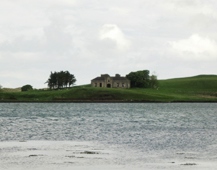Crosspatrick
Houses within 5km of this house
Displaying 9 houses.
Houses within 5km of Crosspatrick
Displaying 9 houses.
| House name | Description | |
|---|---|---|
| Killala Castle | Formerly the residence of the Protestant Bishop of Killala and Achonry, it was occupied by Walter James Bourke and his wife, daughter of the Hon Frederick Cavendish founder of the ''Connaught Telegraph''. The castle was severly damaged by the 'Big Wind' in January 1839. Demolished in the 1950s. | |
| Rosserk | Captain Green resided here in the 1830s. At the time of Griffith's Valuation, Capt Augustus Bolton was occupying a property valued at £10. On the 25-inch Ordnance Survey map of the 1890s a different building, adjacent to a large corn mill and located at G243252, is labelled Rosserk House. Buildings are still extant at this site. | |
| Broadlands | The home of the Knox Gore family, let to Patrick C Howley in the 1830s. It was leased by John Knox, of the Rappa Castle family, at the time of Griffith's Valuation when the house was valued at £15 10s. . A house is still extant at this site. | |
| Bartragh House | A Kirkwood family home in the 19th century. At the time of Griffith's Valuation, the property was leased by William Hopper from the Kirkwood estate when the buildings were valued at £16. A house is still extant at the site though in a dilapidated state. |

|
| Moyne Abbey | Associated with the Lindsey family in the 17th century it was leased to the Knoxes by James O'Hara, Lord Tyrawley, for 999 years in 1741. The Knoxes built a private residence on to the east end of the friary. At various time the Jones, Palmer and Kirkwood families leased parts of Moyne. Thomas Jones sold his interest in the Landed Estates' Court in 1867. The Ordnance Survey Name Books record that Peter Nolan, agent to Sir William Palmer, lived in a neat cottage in the east of the townland. This may be the property labelled Moyne House on the 25-inch Ordnance Survey map of the 1890s (G228287), the remains of which are still extant. | |
| Ballybroony | An 18th century house, occupied by Fallon in the late 1770s and in 1786. The residence of the Perkins family from the early 19th century. It was held by Arthur Perkins from the Earl of Arran at the time of Griffith's Valuation when it was valued at £17. Lived in until the early 21st century and for sale in 2006. Restoration work was underway in 2010. |

|
| Farragh | An 18th century house on the Palmer estate. Wilson refers to it as a residence of Mr. Palmer in 1786. Leased to the Waldrons in the early 19th century and occupied by Hector Sutherland at the time of Griffith's Valuation when the house was valued at almost £8. The original building is no longer extant. | |
| The Lodge | A house with foundations dating from the 17th century, visited by Mary Delaney in the 1730s and occupied by the French in 1798. By 1837 it was the home of T. Kirkwood and, in the mid 19th century, of the Very Reverend J. Collins who held the property valued at £20 from the Ecclesiastical Commissioners. In the late 19th century this house was the home of Captain Alfred Charles Knox, a younger son of John Knox of Castlerea, Killala. Bence Jones writes that the house was enlarged circa 1820 by the addition of a bow shaped wing and that for a time it was the home of the Pery Knox Gore family. In the later 19th century the house was the home of the Timony family who owned a substantial import business in Killala. In the later 20th century owned by Lord Rathcaven and now the Irish home of Noeleen Farrell. |

|
| Rathowen | In 1786 Wilson refers to a house which he calls "Rathrone", a mile and a half West of Killala, which was part of the estate of the Bishop of Killala. At that time it was occupied by James Rogers, though Wilson indicates it was the property of Rev. G. Rogers, Chancellor of Dromore. Most of the townland was in the possession of William Kirkwood, leasing from Harriett Gardiner, at the time of Griffith's Valuation. The house is no longer extant. |

